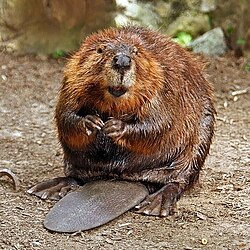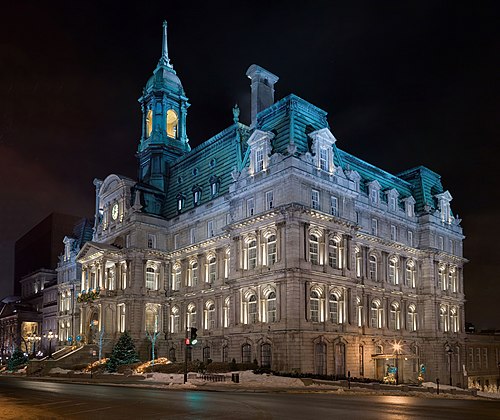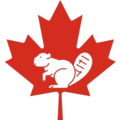Portal:Canada
| Showcase | Contents | Contributing |
Introduction
Canada is a country in North America. Its ten provinces and three territories extend from the Atlantic Ocean to the Pacific Ocean and northward into the Arctic Ocean, making it the world's second-largest country by total area, with the world's longest coastline. Its border with the United States is the world's longest international land border. The country is characterized by a wide range of both meteorologic and geological regions. With a population of just over 41 million people, it has widely varying population densities, with the majority residing in urban areas and large areas of the country being sparsely populated. Canada's capital is Ottawa and its three largest metropolitan areas are Toronto, Montreal, and Vancouver.
A developed country, Canada has a high nominal per capita income globally and its advanced economy ranks among the largest in the world by nominal GDP, relying chiefly upon its abundant natural resources and well-developed international trade networks. Recognized as a middle power, Canada's support for multilateralism and internationalism has been closely related to its foreign relations policies of peacekeeping and aid for developing countries. Canada promotes its domestically shared values through participation in multiple international organizations and forums. (Full article...)
Featured article -

The history of the National Hockey League begins with the end of its predecessor league, the National Hockey Association (NHA), in 1917. After unsuccessfully attempting to resolve disputes with Eddie Livingstone, owner of the Toronto Blueshirts, executives of the three other NHA franchises suspended the NHA, and formed the National Hockey League (NHL), replacing the Livingstone team with a temporary team in Toronto, the Arenas. The NHL's first quarter-century saw the league compete against two rival major leagues—the Pacific Coast Hockey Association and Western Canada Hockey League—for players and the Stanley Cup. The NHL first expanded into the United States in 1924 with the founding of the Boston Bruins, and by 1926 consisted of ten teams in Ontario, Quebec, the Great Lakes region, and the Northeastern United States. At the same time, the NHL emerged as the only major league and the sole competitor for the Stanley Cup; in 1947, the NHL completed a deal with the Stanley Cup trustees to gain full control of the Cup. The NHL's footprint spread across Canada as Foster Hewitt's radio broadcasts were heard coast-to-coast starting in 1933. (Full article...)
Current events
- April 21, 2025 –
- ARK Invest becomes the first US-based asset manager to gain exposure to the Solana blockchain through an ETF investment after Canada approves several spot Solana ETFs. (Coin Market Cap)
- April 16, 2025 – Tariffs in the second Trump administration
- California Governor Gavin Newsom and California Attorney General Rob Bonta file a lawsuit against U.S. President Donald Trump and his administration over the tariffs, making California the first U.S. state to do so. The lawsuit also targets the International Economic Emergency Powers Act, the law used by Trump to impose tariffs against Canada, China, and Mexico. (Politico)
- April 15, 2025 –
- Four people are injured in a vehicle-ramming attack after a person drives a sedan onto a pedestrian walkway on the Toronto Metropolitan University campus near Yonge Street and Gerrard Street in Toronto, Ontario, Canada. (CBC News)
- April 9, 2025 – Tariffs in the second Trump administration, Executive orders in the second presidency of Donald Trump
- Canada announces a 25% tariff on certain vehicle imports from the U.S. as retaliation against a previous similar measure from the U.S. (BBC News)
- April 3, 2025 – Tariffs in the second Trump administration
- Multinational car manufacturer Stellantis announces it will lay off 900 workers across five of its U.S. factories and will pause production at assembly plants in Canada and Mexico in response to the tariffs. (Reuters)
- April 3, 2025 – Canada convoy protests
- The Ontario Court of Justice in Ontario, Canada, convicts Tamara Lich and Chris Barber, two leaders of the truck driver protest movement against COVID-19 vaccination in Canada, of criminal mischief. (AP)
Selected panorama -
National symbol -
The North American beaver (Castor canadensis) is one of two extant beaver species, along with the Eurasian beaver (Castor fiber). It is native to North America and has been introduced in South America (Patagonia) and Europe (primarily Finland and Karelia). The North American beaver is one of the national symbols of Canada and the official state mammal of Oregon and New York. North American beavers are widespread across the continental United States, Canada, southern Alaska, and some parts of northern Mexico. (Full article...)
Selected vital article -
The history of Canada covers the period from the arrival of the Paleo-Indians to North America thousands of years ago to the present day. The lands encompassing present-day Canada have been inhabited for millennia by Indigenous peoples, with distinct trade networks, spiritual beliefs, and styles of social organization. Some of these older civilizations had long faded by the time of the first European arrivals and have been discovered through archeological investigations. (Full article...)
Selected picture -
Featured biography -
Sir John Alexander Macdonald GCB PC QC (10 or 11 January 1815 – 6 June 1891) was the first prime minister of Canada, serving from 1867 to 1873 and from 1878 until his death in 1891. He was the dominant figure of Canadian Confederation, and had a political career that spanned almost half a century. (Full article...)
Did you know -

- ... that Theo Benedet is the first offensive lineman to be named the best Canadian university football lineman two years in a row?
- ... that the entire inventory of historic string instruments in Canada's Musical Instrument Bank are loaned to musicians in a competition held every three years?
- ... that according to Modern Times, a San Francisco–based bookstore collective, if there was only one book that you read in 1975 it had to be Canadian author and activist Helen Potrebenko's Taxi!?
- ... that John Neilson, a Scottish immigrant to Lower Canada, became a major publisher and bookseller, and was reportedly "the largest consumer of paper" in the country?
- ... that during combat, the Canadian-designed SW1C radar failed to find not only its U-boat target, but also an iceberg near the ship?
- ... that Jennifer Jones has won a record-tying six Canadian women's curling championships?
- ... that the Manhattan Project feed materials program used uranium ore from a mine in Canada near the Arctic Circle?
Featured list -
The Grey Cup is the championship of the Canadian Football League (CFL) and the trophy awarded to the victorious team. The trophy is named after Albert Grey, the Governor General of Canada from 1904 until 1911. He donated the trophy to the Canadian Rugby Union in 1909 to recognize the top amateur rugby football team in Canada. By this time Canadian football had become markedly different from the rugby football from which it developed. Although it was originally intended to be awarded only to amateur teams (like the Stanley Cup), over time, the Grey Cup became the property of the Canadian Football League as it evolved into a professional football league. Amateur teams ceased competing for the Cup by 1954; since 1965, the top amateur teams, playing in U Sports, have competed for the Vanier Cup. (Full article...)
Main articles
Associated Wikimedia
The following Wikimedia Foundation sister projects provide more on this subject:
-
Commons
Free media repository -
Wikibooks
Free textbooks and manuals -
Wikidata
Free knowledge base -
Wikinews
Free-content news -
Wikiquote
Collection of quotations -
Wikisource
Free-content library -
Wikiversity
Free learning tools -
Wikivoyage
Free travel guide -
Wiktionary
Dictionary and thesaurus






























